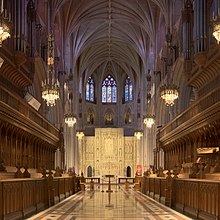Henry Vaughan (architect)
Henry Vaughan | |
|---|---|
 | |
| Born | Henry Vaughan 1845 Cheshire, England |
| Died | June 30, 1917 Newton Centre, Massachusetts, US |
| Occupation | Architect |
| Known for | Church architecture in the English Gothic style |
Henry Vaughan (1845 – June 30, 1917) was a prolific and talented church architect who emigrated to America from England to bring the English Gothic style to the American branch of the Anglican Communion (the Episcopal Church). He was an apprentice under George Frederick Bodley and went on to great success popularizing the Gothic Revival style.
Life[]
Vaughan was born in Cheshire, England. When he was a child, his family relocated to Dollar in Clackmannanshire, Scotland. He attended Dollar Academy, and was awarded a bronze medal in art from the school in 1863. He then began his apprenticeship under Bodley, eventually becoming head draftsman at the firm of Bodley and Garner.
In 1881, Vaughan came to America traveling on the Atlantic Clipper a packet owned by the Glidden and Williams Shipping Company - whose founder William T Glidden lived in Newcastle, ME. Vaughan knew Mr. Glidden and lived at his home on Glidden street in Newcastle ME in 1881 - 1883 in Newcastle, Maine where he designed and built St. Andrews Church( www.standrewsnewcastle.org) which was dedicated on November 22, 1883 on Glidden Street. Later Vaughn moved to Boston and opened an office in Pemberton Square. He never married. He rapidly found success with the Anglican (Episcopal) and Catholic churches. His first commission( not true??- please see above) in the USA was the Chapel of the Society of Saint Margaret.
In the mid-1880s, Vaughan began to receive commissions from Edward Francis Searles, working on numerous projects continuing through until Vaughan's death.
Vaughan died in 1917 in the Boston suburb of Newton Centre, and was interred at the Washington National Cathedral.[1]
Projects[]


Notable Vaughan projects include:
- Chapel of the Society of Saint Margaret, Boston, MA (1881-2)
- St. Mary's Episcopal Church, Dorchester, MA (1888)
- portions of the Cathedral of Saint John the Divine, New York, particularly the chapels to Saint Boniface (1916), Saint James (1916), and Saint Ansgar (1918)
- Washington National Cathedral, Washington, D.C. (with Bodley, later work by Philip Frohman)
- The Episcopal Church of the Mediator in Kingsbridge, NY, called "the little cathedral of the Bronx" (this structure is in need of significant restoration due to water damage from leaks in the original roof; its major interior art pieces and Tiffany windows are protected and in good condition) (1913)
- Christ Church, New Haven, CT (1895-8)
- Holy Cross Monastery, West Park, NY (with Ralph Adams Cram, 1902-4)
- St. John's Chapel, at Groton School, Groton, MA (1899-1900)
- Chapel of St. Peter and St. Paul, at St. Paul's School, Concord, NH (1886-8, 1894)[2]
- , a private home in Dublin, NH
- Amasa Stone Chapel, at Case Western Reserve University, Cleveland, OH (1911)
- Church of the Redeemer Chestnut Hill, MA (1913-5, 1920)
- Church of the Holy Innocents (Hoboken, New Jersey) (1885)

St. John's Chapel, Groton School

Chapel, St. Paul's School, Concord, NH

Searles High School (1898) closed, Great Barrington, MA

Searles High School (1904), now City Hall for Methuen, MA

Searles Castle (1905-1915), Windham, NH
Collaborations with Edward Francis Searles[]
- Searles High School, (1898) Great Barrington MA
- Searles High School (1904), Methuen, MA
- Serlo Organ Hall (completed 1909, now known as Methuen Memorial Music Hall) and Pine Lodge Mansion in Methuen, MA
- Stillwater Manor, a 24-room 3-story mansion in Salem, NH
- Stanton Harcourt Castle, now known as Searles Castle, Windham, NH. 20-room castle completed in 1915 at a cost of approximately $1,250,000, modeled on the Stanton Harcourt Castle in Oxfordshire, England.
- Dream House, now known as Searles Mansion, Block Island, RI. Constructed 1886-1888 as a home for Searles and his wife, it had a "twin house" design with each of the Searles' having a separate identical side of the mansion.
- Mary Francis Searles Science Building, Bowdoin College, Brunswick, ME
- various schools and churches
References[]
- ^ National Park Service: National Cathedral
- ^ "The Architectural History of St. Paul's School". Archived from the original on May 11, 2017. Retrieved March 21, 2016.
William Morgan, The Almighty Wall: The Architecture of Henry Vaughan. New York: The Architectural History Foundation/MIT Press, 1983.
External links[]
| Wikimedia Commons has media related to Henry Vaughan (architect). |
- Methuen Memorial Music Hall
- Searles Castle
- American Institute of Architects, Architectural Record, v. 42, page 286, 1917.
- William Morgan Writings on Henry Vaughn at Dartmouth College Library
- 1845 births
- 1917 deaths
- 19th-century American architects
- Burials at Washington National Cathedral
- Architects from Massachusetts
- People educated at Dollar Academy
- British emigrants to the United States
- 20th-century American architects




